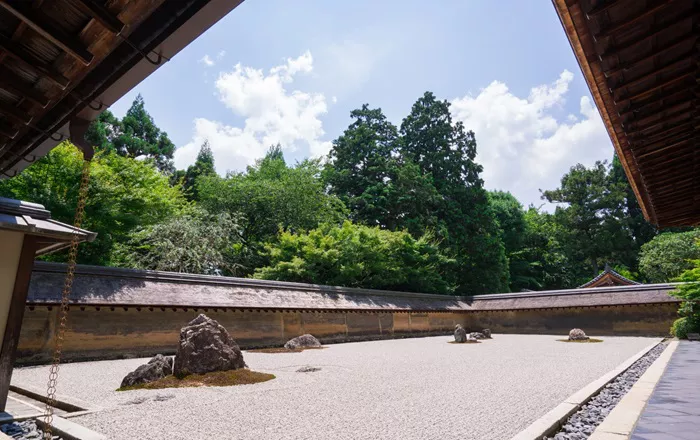Ryoan-ji is a famous Zen Buddhist temple located in Kyoto, Japan. It is well-known for its rock garden, which many consider a masterpiece of Buddhist temples and Japanese culture. The temple is a place where visitors come to find peace and reflect on the meaning of life through simplicity and silence.
History of Ryoan-ji
Ryoan-ji was originally built in the late 15th century during the Muromachi period. It was constructed by a wealthy aristocrat named Hosokawa Katsumoto. Over time, it became a Zen temple and a place dedicated to meditation and teaching Zen Buddhism. The temple’s name means “Peaceful Dragon Temple,” which symbolizes tranquility and wisdom.
The Zen Influence on Ryoan-ji
Zen Buddhism focuses on meditation and mindfulness. It teaches that enlightenment can come through direct experience rather than through scriptures or rituals. Ryoan-ji embodies this teaching with its simple yet profound garden, encouraging visitors to experience calm and insight directly.
The Famous Rock Garden of Ryoan-ji
The most famous feature of Ryoan-ji is its rock garden, often called a “dry landscape garden” or “karesansui.” It consists of carefully placed rocks and white gravel. The gravel is raked daily to create patterns that look like rippling water. The garden is minimalist, yet full of meaning.
Meaning Behind the Garden
People often wonder about the meaning of the rocks and gravel. In Zen, the garden is a tool for meditation. The empty spaces and arrangement encourage viewers to clear their minds and see beyond the surface. The garden does not have a single fixed meaning; it invites personal reflection.
Design Principles
The garden follows principles of asymmetry, simplicity, and naturalness. These principles are common in temple architecture and Zen art. The irregular shapes and placement of stones help create a balance between emptiness and form.
Ryoan-ji and Buddhist Architecture
Besides the rock garden, Ryoan-ji is also important for its buildings and layout. The temple complex includes the main hall, called Hojo, and several smaller structures. These buildings reflect the style of Buddhist architecture, which values harmony with nature.
Hojo: The Main Hall
The Hojo was the living quarters of the head priest. It is a wooden structure with sliding doors that open to the garden, allowing visitors to connect indoor and outdoor spaces. The simplicity of the hall helps focus the mind during meditation.
Connection with Nature
Ryoan-ji is designed to blend with its natural surroundings. Trees, ponds, and stones work together to create a peaceful environment. This connection to nature is a key part of Buddhist temples, supporting mindfulness and respect for life.
The Spiritual Significance of Ryoan-ji
Ryoan-ji is more than a tourist site; it is a place for spiritual practice. The rock garden helps practitioners cultivate patience, focus, and a deeper understanding of impermanence — a central concept in Buddhism. The empty spaces in the garden remind us that life is always changing.
Zen Meditation at Ryoan-ji
Zen meditation, or zazen, involves sitting quietly and observing the mind without attachment. The garden at Ryoan-ji serves as an aid to this practice. Many monks and visitors come to sit and reflect in front of the garden, using its simplicity to calm their thoughts.
Symbolism in Simplicity
The simplicity of Ryoan-ji’s garden represents the Buddhist idea that true understanding comes when we remove distractions and see things as they really are. It is an invitation to let go of material attachments and find peace within.
How to Experience Ryoan-ji
When visiting Ryoan-ji, it is best to approach the garden slowly and quietly. Take time to observe the rocks from different angles and notice how the mind reacts. Each person may see something different, and there is no right or wrong way to experience the garden.
Guided Reflection
Some visitors find it helpful to meditate or quietly ask themselves questions about life while looking at the garden. What do the empty spaces mean? How do the rocks relate to each other? These reflections can open the door to deeper insight.
Respect and Mindfulness
Since Ryoan-ji is a sacred Buddhist site, visitors should show respect by being quiet and mindful. Avoid walking on the garden itself; it is meant to be viewed from specific places. This respect honors the temple’s purpose and the monks who live there.
Conclusion
Ryoan-ji is a unique place where art, nature, and Buddhist teaching come together. Its famous rock garden is a powerful symbol of Zen simplicity and meditation. By understanding the history, design, and spiritual meaning of Ryoan-ji, we can better appreciate its role in Buddhist practice and Japanese culture.

